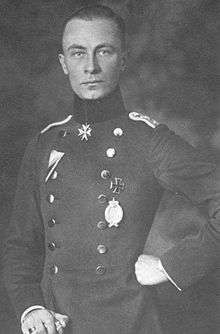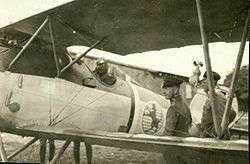Eduard Ritter von Schleich
Eduard-Maria Joseph Ritter von Schleich (9 August 1888 – 15 November 1947), born Schleich, was a high scoring Bavarian flying ace of the First World War. He was credited with 35 aerial victories at the end of the war. During the Second World War he served in the Luftwaffe as a general.
Eduard Ritter von Schleich | |
|---|---|
 Schleich wearing his Pour le Mérite on his neck. | |
| Nickname(s) | "The Black Knight" |
| Born | 9 August 1888 Munich |
| Died | 15 November 1947 (aged 59) Dießen am Ammersee, Bavaria |
| Allegiance | German Empire |
| Service/ | Infantry, Luftstreitkräfte, Luftwaffe |
| Years of service | 1909–1919, 1935–1944 |
| Rank | Lieutenant General |
| Unit | FA 2, Jasta 21, 32, JG IV, JGR 8, SS 28 |
| Awards | Pour le Mérite, Iron Cross 1st & 2nd Class, Knight's Cross of the Military Order of Max-Joseph |
Early life
Born in Munich, Bavaria, the son of an artist, Schleich's family soon moved to the spa city of Bad Tölz. After he left school Schleich decided to enroll in the Bavarian Army's cadet program and in 1909 was commissioned into the 11th Bavarian Infantry Regiment. Before the outbreak of the First World War, Schleich was plagued by medical problems and was released from active duty. He volunteered again and on 25 August 1914 was badly wounded in the Battle of Lorraine.[1]
First World War
While Schleich was recovering from his wounds of August 1914 he decided to volunteer for the Royal Bavarian Air Service and was accepted for training as an observer. After service with FEA 1 on two-seaters, he applied for pilot training and qualified.[2] In December 1915 he joined FA 2b, and in January 1916, during an observation flight, Schleich was wounded in the arm by an exploding anti-aircraft shell. Instead of returning to base, while still in the air he had his crewman bandage his wound and then completed his assignment.[3] On 1 September, he assumed command of Fliegerschule 1.[4] He joined Jagdstaffel 21 (Fighter Squadron 21) in May 1917 and commanded the unit from June onwards. He emblazoned his new Albatros D.V with a rampant lion insignia representing Bavaria.[5]
When Leutnant Erich Limpert, his best friend on the Jasta, was killed in a dogfight, Schleich ordered his plane to be painted all black. This black plane soon led to Schleich being dubbed 'The Black Knight'.[6]

In October 1917, the Imperial German Air Service reorganized, with the respective fighter squadrons being designated as Prussian, Saxon, or Bavarian. The squadrons were then stocked only with subjects from their respective provinces. Jagdstaffel 21 thus became a Saxon squadron, and Schleich being Bavarian, was transferred to command a Bavarian squadron, Jagdstaffel 32,[7] with his tally of victories then at 25.[8]
He was awarded the Pour le Mérite on 4 December 1917,[8] and after a spell commanding Militaerfliegerschule 1,[9] on 15 March 1918 he took command of Jagdgruppe Nr. 8, an ad hoc group consisting of Jastas 23, 34 and 35.[10] By the war's end his score was 35. [11] Having scored 29 of his 35 victories in the Albatros D.V, he's the most successful pilot in the type.
Interbellum
Schleich was briefly hospitalised in Bad Reichenhall, regaining his strength after years of combat.[12] In 1919, he was posted as an Inspector with the Bavarian Air Service, an aviation unit of the Bavarian State Police.
In April 1919, the German Communist Party forcibly gained control of Munich, and Schleich was marked for immediate arrest and trial.[13] Government troops were able to oust the Communists the following month, returning Bavaria once again to the Weimar Republic.
After a short stint as a pilot with the Bavarian Police, Schleich became a liaison officer with the Army Peace Commission, responsible for the implementation of the Armistice terms.[14]
Demobilised in December 1921,[15] Schleich worked as a peat farmer,[16] and later as an airline pilot.[17] In 1922, he helped start the Bavarian Flying Club.[18] In mid-October 1929, Schleich quit his pilot's position with Lufthansa. At about the same time, he founded the Light Airplane Club in Munich.[19]
He joined the Nazi Party on 1 April 1931,[20] and at the same time became a member of the SS-Fliegerstaffel, a paramilitary flying organization. He was given control of the Hitler Youth flying programmes, and promoted to General.[21]
With the creation of the Luftwaffe in 1935, Schleich returned to military service with the rank of a Major,[22] overseeing the training of air reserve units and of dive-bombing pilots. He was then assigned to command the new Jagdgeschwader 234 in 1937.[23]
Schleich was promoted to Oberst and assigned to Jagdgeschwader 132 ‘Schlageter’, tasked with defending the western frontier of Germany.[24] Re-designated in 1939 as Jagdgeschwader 26, the wing saw only limited service during the initial phases of the Second World War.
Second World War
As a Generalmajor, Schleich became the commander of the fighter pilot school (Jagdfliegerschule 5) at Vienna-Schwechat, Austria, in December 1939.[25] In late 1940 he was sent to Romania as part of the Luftwaffe Mission, assisting in the organization and training of the Romanian Air Force.[26]
In mid-1941 Schleich then became Commander of the Occupation Forces in Denmark, spending nearly two and one-half years there. On 29 August 1943, the Germans launched Operation Safari, von Schleich commanded an attack on Sorgenfri Palace, resulting in a firefight and the death of seven Germans.[27][28]
Schleich’s final assignment was Luftwaffe Ground Forces Commander in Norway, a post he held until late 1944. The regional command was disbanded in September, nine months after he arrived. Placed onto the reserve list in mid-November, Schleich eventually retired as a Generalleutnant.[29]
Eduard Ritter von Schleich died on 15 November 1947, aged 59 years, from a heart condition. Schleich was buried in Diessen am Ammersee, near Munich.[30]
Decorations
- Prussian Iron Cross of 1914
- 2nd Class: 25 October 1914
- 1st Class: 1 April 1916
- Bavarian Military Merit Order 4th Class with Swords: 28 March 1916
- Prussian Order Pour le Mérite: 5 December 1917
- Bavarian Military Merit Order with Crown and Swords: 9 December 1917
- Bavarian Knight's Cross of the Military Order of Max Joseph: 7 July 1918
- Saxony's Order of Albert 2nd Class with Swords: 29 July 1918[31]
Endnotes
- Whiteside (2007), pp. 1–6.
- Whiteside (2007), pp. 6–7, 9–10.
- Whiteside (2007), pp. 9, 17–19.
- Whiteside (2007), p. 29.
- Whiteside (2007), pp. 37, 47.
- Whiteside (2007), pp. 63–65.
- Whiteside (2007), p. 93.
- Whiteside (2007), p. 95.
- Whiteside (2007), p. 96.
- Whiteside (2007), pp. 102–103.
- Whiteside (2007), pp. 267–268.
- Whiteside (2007), pp. 141, 145.
- Whiteside (2007), pp. 148–149.
- Whiteside (2007), pp. 152–155.
- Whiteside (2007), p. 158.
- Whiteside (2007), pp. 166–167.
- Whiteside (2007), pp. 167–171.
- Whiteside (2007), p. 164.
- Whiteside (2007), pp. 176–177.
- Whiteside (2007), p. 178.
- Whiteside (2007), pp. 184–185, 196–197.
- Whiteside (2007), pp. 209–210.
- Whiteside (2007), pp. 215–220.
- Whiteside (2007), pp. 221–222.
- Whiteside (2007), pp. 231–232.
- Whiteside (2007), pp. 234–235.
- Otzen, Theis (21 April 2015). "The Germans Attacked Sorgenfri Palace". Gentofte Lokalavisen (in Danish). Retrieved 23 December 2017.
- Whiteside (2007), pp. 235–244.
- Whiteside (2007), pp. 246–250.
- Whiteside (2007), p. 257.
- Whiteside (2007), pp. 279–280.
References
- Whiteside, Darren J. (2007). Rampant Lion: The Life of Eduard Ritter von Schleich, Germany's 'Black Knight' of WWI. Warren, Michigan: A & S Publishing. ISBN 978-0-9791946-1-0. LCCN 2007903331.CS1 maint: ref=harv (link)
External links
| Military offices | ||
|---|---|---|
| Preceded by none |
Commander of Jagdgeschwader 26 Schlageter 1 November 1938 – 9 December 1939 |
Succeeded by Major Hans Hugo Witt |
| Preceded by none |
Commanding General of the Luftwaffe in Denmark 12 June 1941 – 1 May 1944 |
Succeeded by Generalmajor Andreas Nielsen |
| Preceded by General Josef Kammhuber |
Commanding General of the Luftwaffe in Norway 10 October 1944 – 15 November 1944 |
Succeeded by Generalleutnant Ernst-August Roth |